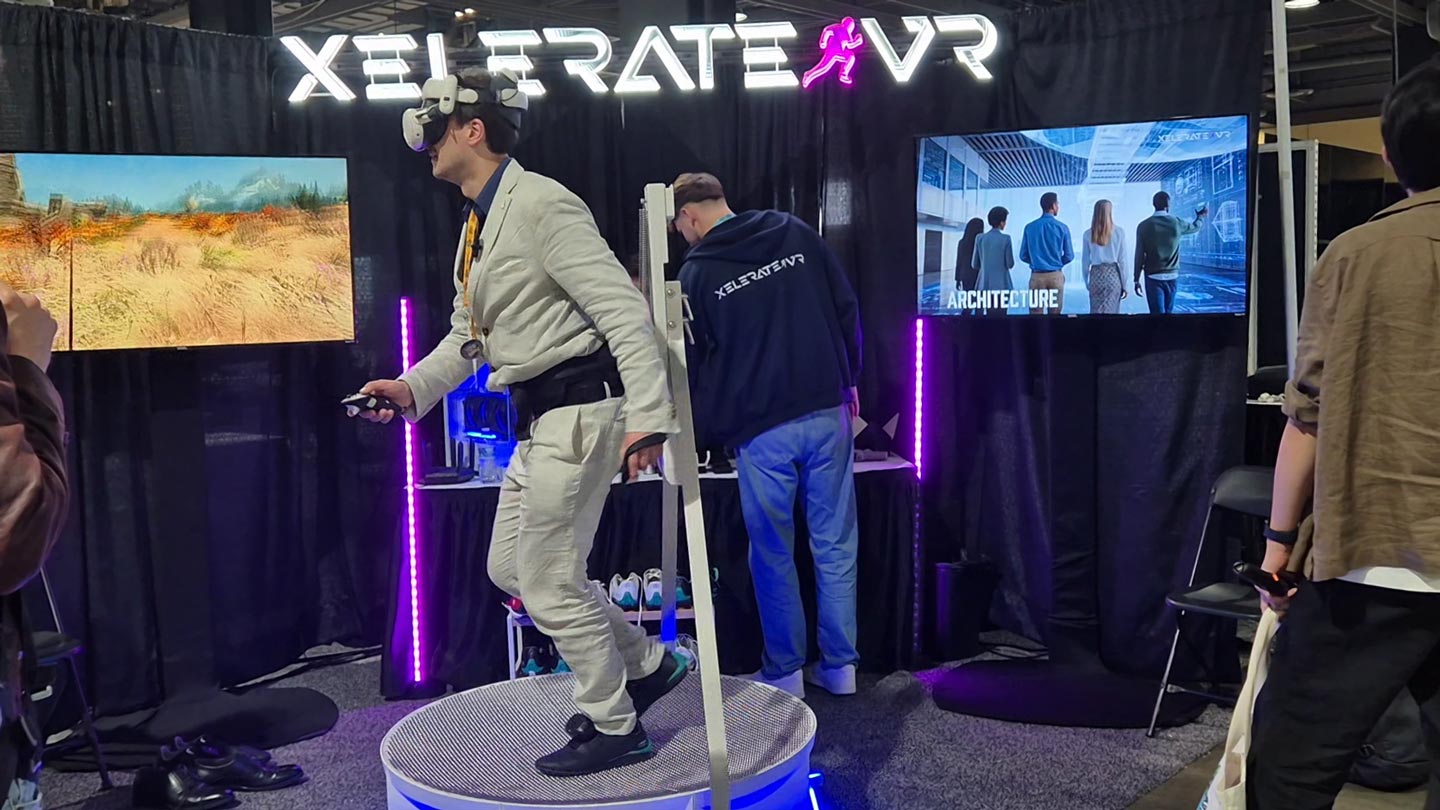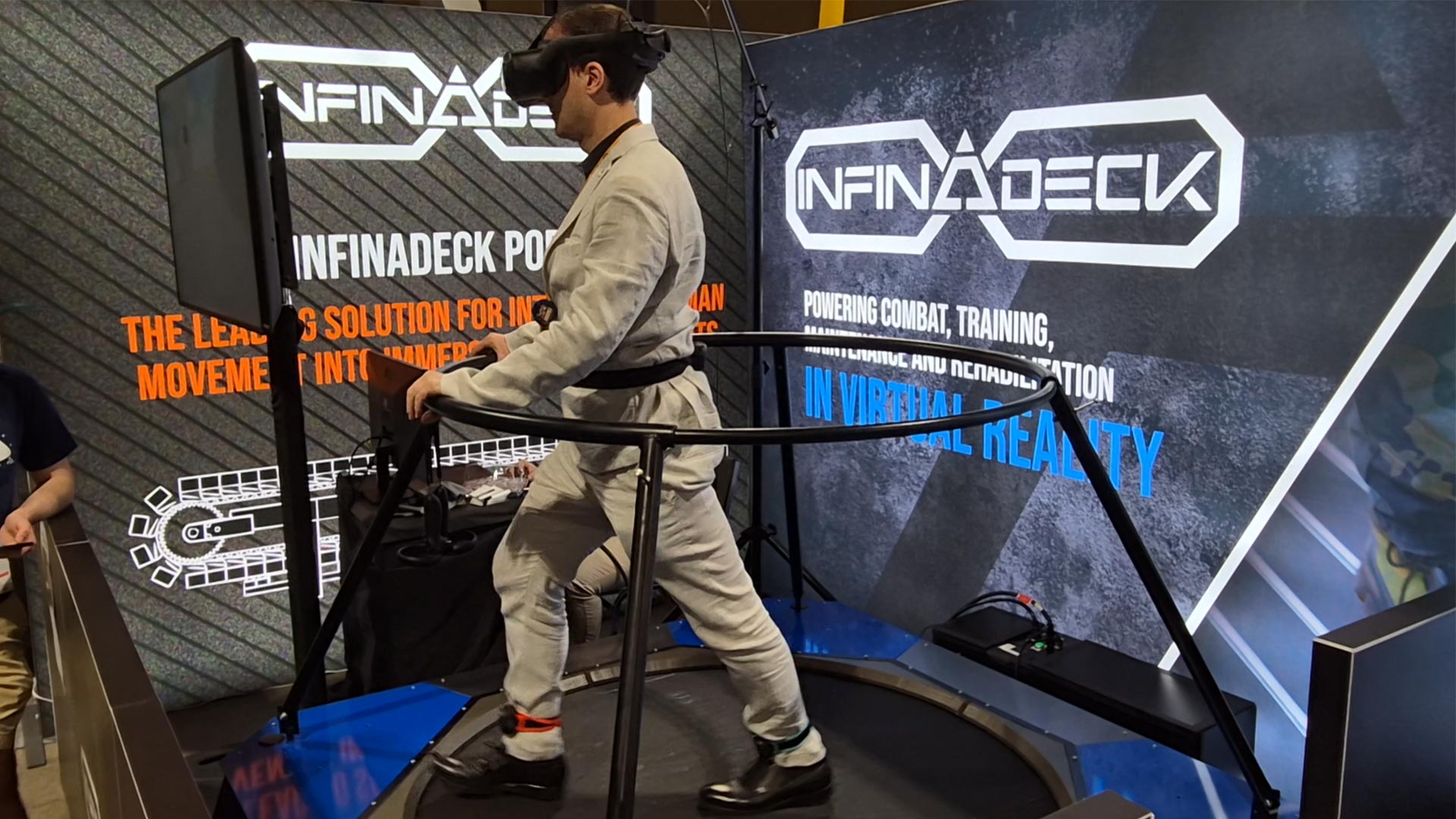AWE: Hands-on Logitech stylus for Quest, Petaray lightfield AR, and Spacebar Arcade!
AWE US has come to an end. It’s been very tiresome, but in the end, I loved to go there. It has been a great occasion to reconnect with many friends, meet new people, and do useful business meetings. I also met Palmer Luckey for the first time there! I am super tired, but I’m very happy, it has been a good event for me, and I also fulfilled all the goals that I had set before the event. I have also tried a lot of stuff about which I’ll write in the upcoming weeks, so stay tuned!
Today I have selected three highlights from the event for you: the Logitech MX Ink, Petaray, and Spacebar Arcade. Have fun reading about them…
Logitech MX Ink stylus hands-on
Logitech did not have a booth on the AWE show floor, but its new MX Ink stylus meant for drawing in VR was hidden inside the Meta booth and the demos were carried on not by Meta but by Shapes XR. We were all very confused about why there was no stress on this very interesting gadget, but that’s none of my business. Theoretically, I should have booked a slot for a demo of the MX Ink, but I kindly asked the guys of ShapesXR to make me try the device anyway making the same facial expression as Shrek’s Puss In Boots and in the end, they gave me a few minutes with the pen. Big thanks to the ShapesXR people and also to Keiichi Matsuda who was trying the pen before me and interrupted his test to let me have mine (Keiichi I love you).

The Logitech MX Ink stylus looks like… a stylus. It is like a big plastic black pen with a final tip that features a pressure sensor. Close to the tip, you can see three buttons that you can use to interact with the application (the functions of the buttons depend on the application itself) on one side, while on the other side, you can see the tiny electrical contacts that are used for the charging of the device on the dock. Not visible to the eye, but on the device there are also many tracking LEDs that are tracked by the cameras of the Quest. This is the first third-party accessory that is tracked with the headset tracking cameras.


When I put the headset on and I grabbed the pen, the first thing that I noticed is that it was represented inside Shapes XR as a perfect virtual representation of itself. I mean, it had its virtual counterpart that matched exactly the appearance of the physical device, like the official controllers, and this shows even more how this gadget is deeply integrated into the Quest ecosystem.
The second thing I noticed is that it didn’t feel completely right in my hand. I didn’t have time to thoroughly test the device (I had just a few minutes), but in the time I had, I couldn’t find a way to make it properly fit my hand. It was as if it always was slightly uncomfortable, maybe because a bit too big (it is thicker than a pen).

The guy from Shapes XR gave me a crash course on how I could use the pen inside their application: I could use the “upper button” (the one more distant from the tip) to select the tool I wanted (e.g. brush vs eraser), the central big button to use the current tool, and the lower button to grab elements. The central button is also what works as the main trigger of the device, and in fact it is bigger than the other ones. I guess that if you want to use the pen as a controller, you just move it in space and then use the central button to activate the various menu items.
I started drawing, and I found immediately how drawing with a stylus is much more comfortable than using a controller. It’s more accurate and more similar to the tools that we as humans have always used to draw: pens, pencils, brushes, etc… The first thought I had was drawing a dick as usual, but then I realized that probably ShapesXR people wouldn’t have been so happy with it (even if, technically, even that one is a “shape” in XR), so I went on another symbol of love, which is the heart. The drawing was so smooth and accurate to perform.
I didn’t have the time to make many tests about the tracking quality (like to verify the tracking FOV), but for the use I did, the tracking was very accurate. It was like using a Quest controller. This means that at least for standard use, it is very good.
I enjoyed a lot drawing with the pen, but I had a big problem with it and it was about the positioning of the buttons. The three buttons are very small and very close, so when I wanted to press the central button to draw, I inevitably finished to also press the upper button to change the current tool. This didn’t happen just once, but many times: I wanted to draw and I ended up changing the tool and then activating whatever tool I randomly selected. This was very frustrating. Again, take this negative feedback with a grain of salt because I didn’t have the time to study the ideal position to take it in my hand, but still, I have to report I had this problem. Other people I’ve spoken with didn’t have the same issue, so probably it depends on the size of your hand.

I spent a few minutes drawing with the tool and it was fun. I’ve also used the lower button to grab elements from the ShapesXR menu and drag them into the scene or to grab some previously drawn strokes and move them. It was all very natural and accurate.
But the thing that I loved the most about the Logitech MX Ink in ShapesXR was drawing on a surface. The MX Ink tip has a pressure sensor, so you can press it on a surface to draw. When you draw on a surface, since you are already activating a sensor, you don’t need to also press a button, so the issue I had with the buttons could not happen in this case. The sensation that I had while drawing on the desk of the booth was amazing: it was like drawing with a real pen. It was natural, I needed no explanation, no thinking… I was just drawing with my physical pen on a physical surface! That was fucking cool, it was my favorite part of the demo.

In the end, I can say that my experience with the Logitech MX Ink pen inside ShapesXR was overall positive. It represented a much more natural way of drawing and positioning objects in the scene. The device is also well-made and well-tracked, and the only problem for me was finding the best way to grab it to avoid problems with its buttons.
Petaray
Petray does lightfields for augmented reality. The peculiarity of Petaray is that since it offers lightfields, it goes beyond the classical stereoscopy of current AR glasses. To show what it means, Petaray had a demo at its booth: they had like a castle made with cardboard, and in AR you could see a dragon flying around it. At first, you could see the dragon with traditional AR, so the classical stereoscopy: you could see the dragon in 3D, but you could not see it in the same focus as the castle. Then there was the demo with Petaray’s system, and you could clearly focus on the flying dragon at the depth it was, and you could focus on both the dragon and the physical objects at the same time if they were at the same depth. This is the magic of lightfields, which will be the future of augmented reality.

There was no Vergence-Accomodation conflict, but the augmentations suffered from all the usual problems that AR has today: the resolution was not super crisp, the FOV was limited, and the virtual elements were semi-transparent. But still, it was an interesting demo to have, because being able to focus naturally on virtual objects with your eyes is great.

I asked Petaray’s spokesperson what the differences are between them and CREAL and he told me that they are two different approaches. In his opinion, the strength of Petaray is that their light engine does not consume electrical energy to create the lightfields. I don’t know how it is possible, so I will just report this statement.
Petaray does not make glasses but optical engines and is looking for interested OEMs to integrate its technology. It had in the booth a “reference design” of the glasses that could be built using the PetaRay engine, and you can see it in the image here below.

If you are interested in this company, you can find more info at PetaRay’s website: https://www.petaray.com/
Spacebar Arcade
My friend Sam Mateosian had one of the best-looking booths at AWE: it looked like a big arcade machine located on the Showfloor Playground area. On the last day, at the last minute, I managed to try his demo. I tried two things in his arcade. The first one was a VR pinball game played with a physical pinball controller. It was cool playing 3D pinball in VR using physical buttons I could press with my hands like in a real physical machine. I’ve been told that the plan with the Pinball is to make it multiplayer, with a person playing with the pinball machine in a standard way, and another one playing by staying “inside the pinball”. That sounds interesting, but unluckily it was not possible for me to try this at AWE.
While I was playing the pinball, I looked around me in VR and I saw other stuff, but I didn’t exactly realized what they were until Sam put me another Quest headset which was on the table of the booth. With this other Quest headset, I was not tied to a pinball, but I could move around a location that had retro-fluo minimalistic graphics where I could play various minigames in multiplayer with the other people that were around me. So for instance, I could start a game of Pong with another player: we both stood in front of the machine, one for each side, we grabbed the paddles and started to play. I also played a game of Darts alone, by launching the darts towards a target. The idea is to let people play fun mini-games together like we all did (and sometimes still do) inside an arcade room.
It’s a nice concept, but the version of Spacebar Arcade I could try at AWE was still a prototype needing a lot of refinement. Sam is working on it and the plan is to release it on the VR stores when it will be ready. For the people interested in knowing more about it, there is also a Discord server.
You can find more information about it at this website: https://spacebar.games/
Disclaimer: this blog contains advertisement and affiliate links to sustain itself. If you click on an affiliate link, I'll be very happy because I'll earn a small commission on your purchase. You can find my boring full disclosure here.



